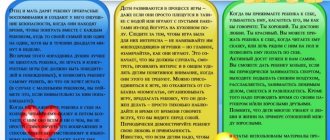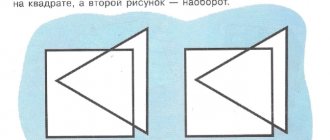“Journey to the City of Masters” /summary of the final lesson on FEMP in the preparatory group/
ABSTRACT
in mathematics with elements of speech development
"Journey to the City of Masters"
Program content:
- Concretize children's concepts about the composition of the numbers of the first ten.
- Practice adding numbers to any given number; replace a number with a sum of numbers, one of which is “3”: 6= 3+?; 7=3+?; etc. to 10.
- Teach children to navigate the plane of a sheet: draw segments of a given length.
- Practice the ability to restore the order of numbers in ascending order.
- Recognize familiar geometric shapes, identifying common features and differences, and finding a given shape.
- Develop speech, form adjectives from nouns: iron roof - iron roof, brick wall - brick wall, wooden bench - wooden bench, etc.
- Develop logical thinking, attention, and reasoning skills.
Material:
magnetic alphabet, table - the key to solving the name, image of a geometric castle, images of geometric shapes, diagrams - flower beds with tasks on the composition of numbers, notebooks for everyone, pencils, rulers, printouts with dotted images of intersecting geometric shapes, fans, digital cards.
Progress of the lesson:
1.
Game “Add the letters in ascending order of numbers.”
Guys, today an unusual parcel was brought to the garden. What's in it, let's see? (Open: magnetic alphabet.) Letters, but what does it mean? Here's a note, who can read it? (Read: “Arrange the letters in ascending numerical order and you will find out where they are waiting for you...”). And here is the table:
| 3 | 1 | 4 | 5 | 2 | 7 | 6 | 9 | 8 | 11 | 10 | 13 | 12 |
| R | G | O | d | O | A | m | T | With | R | e | V | O |
Children restore the order of the numbers and put the name on the board: CITY OF MASTERS. So this is where they are waiting for us, in the city of masters. Who lives there, do you think? (Answers.) That's right, masters of their craft, people of different professions.
2. Game “Guess the profession.”
Let's play: I say what this person does, and you say the name of the profession: he teaches children -... (teacher), treats people... (doctor), protects the forest... (forester), sells goods... (seller). And now it’s the other way around: what does a tailor do?... (sews clothes), a carpenter... (carpenters, saws, planes), a builder... (builds), a glazier... (inserts glass). Well done. So, let's hit the road! But the road is not easy, you have to go through the labyrinth and not get lost. And our friend Pencil will help us with this. Sit down at the tables, open your notebooks. (Pay attention to the position and the rules for gripping a pencil.)
3.
Game task “Graphic dictation “Key”.
And the labyrinth, guys, leads straight to the key to the City of Masters. Be careful. We will draw using a ruler: first we count as many cells as I say, put a point, apply a ruler and connect the ends of the segment with a line. And so on until we reach the key. The game begins:
Down 2 cells, left 1 cell, down 3 cells, right 5 cells, up 3 cells, left 1 cell, up 2 cells, right 6 cells, down 5 cells, left 3 cells, up 2 cells, right 6 cells.
Whoever completed the task correctly found... the right key
from the city of Masters.
4.
Game “Turn a noun into an adjective.”
Keys are made of metal, which means the key... (metal). The houses in the city of craftsmen are made of stone, that means... (the houses are stone), and if they are made of brick, then... (the houses are brick), the roofs are made of tiles, that means... (the roofs are tiled), the benches are made of wood, that means... (the benches are wooden), windows made of glass, that means... (glass windows). Well done, right.
5.
Game “Recognize and name the figure.”
Castles are built by masters -... builders. They build a beautiful castle from different figures. What are the names of all these figures? (geometric). Are there any quadrilaterals here? Name them. (Children call: square, rhombus, rectangle, trapezoid). How are they similar? (4 corners and 4 sides). What is the difference? (different angles and side lengths). Right. How many triangles are there in the castle? (4). What figure is not in the castle?
6. Game task “Choose the desired figure.”
Who puts glass in window frames? (Glazier.). But the glass was mixed up. He can't find the right shape of glass. Help him. You have leaves with figures of different shapes, circle the figure suitable for the castle windows in red.
Well done, you completed the task. They built a large and beautiful castle. Close your notebooks and come to me.
7.
Dynamic pause.
Shake off with fingers and brushes. Game “Fun Counting” (Performing movements on each count. The movements are agreed upon in advance. For example: “One” - clap their hands, “two” - jump, “three” - squat, etc. up to ten and in reverse order.)
8.
Arithmetic game “Guess how many colors there are?”
There is a beautiful garden around the castle. It employs... a gardener. Look, he has 5 flower beds: in each he planted 3 flowers. But you need to annoy as much as the number is in the center of the flowerbed circle. How many flowers should be planted in 1 flowerbed? (3, etc.)
9. RESULTS
: Our journey to the city of masters has ended. Masters of other professions also live in this city. You will get to know them in other classes. Who liked to do what today: counting, drawing, recognizing shapes, putting letters in place? (Children answer.)
They return back to kindergarten again by train.
Final GCD in mathematics in the preparatory group: Topic: “Flower - seven-colored”
Final GCD in mathematics in the preparatory group:
Topic: “Flower - seven-flowered”
Age group:
children of the preparatory group.
Target:
Exercise children in using mathematical knowledge in a gaming situation.
Educational objectives:
1. Improve skills in direct counting within 20, quantitative and ordinal counting, understanding counting and numbers up to 20.
2. Learn to correlate numbers with the number of objects, solve problems.
3. To consolidate knowledge about geometric shapes and the ability to create images of objects from geometric shapes, to navigate the plane of the sheet.
4. Find your bearings in the sequence of days of the week.
Developmental tasks
:
1. Develop attention, intelligence, and the ability to navigate in space.
2.Develop curiosity, mutual assistance, and independence.
Educational tasks:
1. Cultivate interest in mathematical knowledge; the ability to understand a learning task; the desire to help the heroes of the fairy tale; do good deeds for your comrades and loved ones; desire to show off your knowledge.
2. Foster a positive attitude towards learning activities.
Preliminary work
: Solving logical problems, working with geometric shapes, working with cards, reading V. Kataev’s fairy tale “The Flower of Seven Flowers.”
Material:
Cards with numbers for each child, a flower with seven petals, cards with geometric shapes for each child, 10 different toys, magnetic board, magnetic numbers, geometric shapes for each child, 7 pieces of bagels, a letter, cards - tickets with numbers from 1 to 10, a bag of treats.
Progress of activities:
Children stand near the teacher in a semicircle.
Educator: Guys, I want to invite you on a journey through a fairy tale, and which fairy tale we will go to, I will read in the letter that the storyteller sent us yesterday. Oh, but there is no letter, but instead of a letter, here is a piece of paper and the signature “Old Lady”; Let's see what's on the piece of paper - this is the plan according to which we need to find the letter. Can you children help me find the letter?
Children: Yes.
Children follow the route following the words (turn right, 2 steps forward, turn left, three steps forward, etc.)
The children find the letter.
The teacher reads: Today we will go to V. Kataev’s fairy tale “Flower - seven-colored flower. Once upon a time there lived a girl, Zhenya. Mom sent her to the store for bagels. The girl bought bagels.
Two for dad, two for mom, two for myself and one for my brother. How many lambs did Zhenya buy?
Children: 7 bagels
Educator: Let's check.
Children count the bagels that are on the table. (Children's answer.)
Educator: Correct.
Educator. But while Zhenya was walking home and looking at the store windows, the dog ate the bagels. The girl ran after the dog and did not catch up, but she met an old woman who gave the girl a magic flower. Look at the flower that lies on the table. What flower does it look like?




